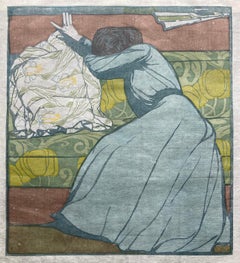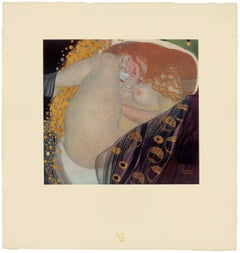Max Kurzweil Art
to
2
2
2
Overall Height
to
Overall Width
to
2
2
1
1
1
1
2
2
2
6,952
3,302
2,514
1,213
1
1
Artist: Max Kurzweil
POLSTER (The Cushion)
By Max Kurzweil
Located in Santa Monica, CA
MAXIMILLIAN KURZWEIL (Austrian 1867-1916)
DER POLSTER / THE CUSHION, 1903. Color woodcut printed on laid japon paper, affixed as usual to a support sheet from its upper sheet edge...
Category
Early 1900s Vienna Secession Max Kurzweil Art
Materials
Woodcut
Der Polster
By Max Kurzweil
Located in New York, NY
Kurzweil, Maximilian. Der Polster, 1903. Color woodcut on japon. Included as an insert in Pan. Unsigned. Framed.11 1/4 x 10 1/4. 1
Ref: Hofstatter, p. 241; Pabst, p. 154.
Maximillian Kurzweil was the co-founder of the Vienna Secession in 1897 and editor and illustrator of the influential Secessionist magazine Ver Sacrum...
Category
Early 1900s Vienna Secession Max Kurzweil Art
Materials
Lithograph
Related Items
H.O. Miethke Das Werk folio "Water Snakes II" collotype print
By Gustav Klimt & K.K. Hof-und Staatsdruckerei
Located in Chicago, IL
Water Snakes II, no. 9 from the fourth installment of Das Werk Gustav Klimts
The last painting Klimt exhibited with the Secession before resigning, Water ...
Category
Early 1900s Vienna Secession Max Kurzweil Art
Materials
Paper
H.O. Miethke Das Werk folio "Danaë" collotype print
By Gustav Klimt & K.K. Hof-und Staatsdruckerei
Located in Chicago, IL
Danaë, no. 2 from the fourth installment of Das Werk Gustav Klimts
Danae originates from Greek mythology. She is the daughter of the King of Argos. Because a...
Category
Early 1900s Vienna Secession Max Kurzweil Art
Materials
Paper
Ottokar Mascha Folio, plate 8: "Poster for the 1st Vienna Secession Exhibition"
By Gustav Klimt
Located in Chicago, IL
After GUSTAV KLIMT (1862-1918) THESEUS UND MINOTAURUS, 1898, final design submission for poster advertising the first exhibition of the Vienna Secession, (In Mascha, no. 8) As a cele...
Category
1910s Vienna Secession Max Kurzweil Art
Materials
Lithograph
Fruhling
By Josef Siccard-Redl
Located in New York, NY
Siccard-Redl, Josef. Fruhling, Ca 1910. Color wood engraving, Signed and titled in pencil by the artist.
Little is known of this artist other than he worked in Vienna during the
...
Category
1910s Vienna Secession Max Kurzweil Art
Materials
Engraving
Gerlach's Allegorien Plate #75: "Hunting, Fishing, Rowing, Cycling"
By Koloman Moser
Located in Chicago, IL
Koloman Moser
(1868 –1918), AUSTRIAN
Instead of applying his flair and art education solely to painting, Koloman Moser embodied the idea of Gesamt Kunstwerk (all-embracing art work) by designing architecture, furniture, jewelry, graphics, and tapestries meant to coordinate every detail of an environment. His work transcended the imitative decorative arts of earlier eras and helped to define Modernism for generations to come. Moser achieved a remarkable balance between intellectual structure (often geometric) and hedonistic luxury.
Collaborating with Gustav Klimt and Josef Hoffmann, the artist was an editor and active contributor to Ver Sacrum, (Sacred Spring), the journal of the Viennese Secession that was so prized for its aesthetics and high quality production that it was considered a work of art. The magazine featured drawings and designs in the Jugendstil style (Youth) along with literary contributions from distinguished writers from across Europe. It quickly disseminated both the spirit and the style of the Secession.
In 1903 Moser and Hoffmann founded and led the Wiener Werkstatte (Viennese Workshop) a collective of artisans that produced elegant decorative arts items, not as industrial prototypes but for the purpose of sale to the public. The plan, as idealistic then as now, was to elevate the lives of consumers by means of beautiful and useful interior surroundings.
Moser’s influence has endured throughout the century. His design sensibility is evident from the mid-century modern furniture of the 1950s and ‘60s to the psychedelic rock posters...
Category
1890s Vienna Secession Max Kurzweil Art
Materials
Lithograph
The Drunkard in Spring —after Gustav Mahler's 'The Song of the Earth'
Located in Myrtle Beach, SC
Arthur Paunzen, 'Der Trunkene im Frühling' (The Drunkard in Spring) from the suite 'Song of the Earth', etching, aquatint, and drypoint, 1920. Signed and titled in pencil. Signed in the plate, lower right. A fine, richly-inked impression, on cream, wove Japan paper; the full sheet with margins (2 1/4 to 4 1/4 inches), in good condition. Image size 12 3/8 x 9 1/8 inches; sheet size 19 5/8 x 13 5/8 inches. Matted to museum standards, unframed.
ABOUT THIS WORK
Pauzen’s suite of six etchings 'Das Lied von der Erde' (The Song of the Earth), published in 1920, was inspired by Gustav Mahler...
Category
1920s Vienna Secession Max Kurzweil Art
Materials
Etching, Drypoint, Aquatint
E. Strache, Handzeichnungen folio, "Nursing Mother with Child" Collotype plate
By (after) Egon Schiele
Located in Chicago, IL
after Egon Schiele (1890 – 1918), AUSTRIA
“ART CANNOT BE MODERN, ART IS PRIMORDIALLY ETERNAL.” -SCHIELE
Defiantly iconoclastic in life and art, Egon Schiele is esteemed for his mas...
Category
1920s Vienna Secession Max Kurzweil Art
Materials
Paper
Gerlach's Allegorien Plate #89: "Bookplate Spring" Lithograph
By Koloman Moser
Located in Chicago, IL
Koloman Moser
(1868 –1918), AUSTRIAN
Instead of applying his flair and art education solely to painting, Koloman Moser embodied the idea of Gesamt Kunstwerk (all-embracing art work) by designing architecture, furniture, jewelry, graphics, and tapestries meant to coordinate every detail of an environment. His work transcended the imitative decorative arts of earlier eras and helped to define Modernism for generations to come. Moser achieved a remarkable balance between intellectual structure (often geometric) and hedonistic luxury.
Collaborating with Gustav Klimt and Josef Hoffmann, the artist was an editor and active contributor to Ver Sacrum, (Sacred Spring), the journal of the Viennese Secession that was so prized for its aesthetics and high quality production that it was considered a work of art. The magazine featured drawings and designs in the Jugendstil style (Youth) along with literary contributions from distinguished writers from across Europe. It quickly disseminated both the spirit and the style of the Secession.
In 1903 Moser and Hoffmann founded and led the Wiener Werkstatte (Viennese Workshop) a collective of artisans that produced elegant decorative arts items, not as industrial prototypes but for the purpose of sale to the public. The plan, as idealistic then as now, was to elevate the lives of consumers by means of beautiful and useful interior surroundings.
Moser’s influence has endured throughout the century. His design sensibility is evident from the mid-century modern furniture of the 1950s and ‘60s to the psychedelic rock posters...
Category
1890s Vienna Secession Max Kurzweil Art
Materials
Lithograph
H 17.25 in W 13.75 in
H.O. Miethke Das Werk folio "The Kiss" collotype print
By Gustav Klimt & K.K. Hof-und Staatsdruckerei
Located in Chicago, IL
The Kiss, no. 1 from the fifth installment of Das Werk Gustav Klimts
Undoubtedly Klimt’s best known and most reproduced images, this printed version of The Kiss is the only one with which Klimt was directly involved. Unveiled at Vienna’s Kunstschau 1908, and saved for the fifth and final delivery of Das Werk, The Kiss marks a triumph in Klimt’s career and represents a culmination of many themes in his oeuvre up to that point. After all of the controversy surrounding the State’s prior rejection of the University murals commissioned from Klimt, the Ministry of Education reversed their policy toward the artist with a show of wholehearted support by purchasing for the Osterreichische Galerie BelvedereThe Kiss while it still hung in the Kunstschau exhibit.
Considered in relation to the eight multicolored collotypes which preceded its print debut in the Das Werk portfolio, The Kiss literally embraces all which came before it. The golden seaweed dangling in tresses from the lovers’ feet harkens back to Water Snakes I and II. The bed of flowers evokes the settings Klimt created in both The Golden Knight and The Sunflower. In fact, this image sprung out of a particularly happy summer spent in the company of Klimt’s lover, Emilie Floge...
Category
Early 1900s Vienna Secession Max Kurzweil Art
Materials
Handmade Paper
Gerlach's Allegorien Plate #37: "Music" Lithograph
By Koloman Moser
Located in Chicago, IL
Koloman Moser
(1868 –1918), AUSTRIAN
Instead of applying his flair and art education solely to painting, Koloman Moser embodied the idea of Gesamt Kunstwerk (all-embracing art w...
Category
1890s Vienna Secession Max Kurzweil Art
Materials
Lithograph
The Solitary One in Autumn—after Gustav Mahler's 'The Song of the Earth'
Located in Myrtle Beach, SC
Arthur Paunzen, 'Der Einsame im Herbst' (The Solitary One in Autumn) from the suite 'Song of the Earth', etching, aquatint, and drypoint, 1920. Signed and titled in pencil. Signed in the plate, lower left. A fine, richly-inked impression, on cream, wove Japan paper; the full sheet with margins (2 3/8 to 4 1/8 inches), in good condition. Image size 12 3/8 x 8 7/8 inches; sheet size 19 5/8 x 13 3/4 inches. Matted to museum standards, unframed.
ABOUT THIS WORK
Pauzen’s suite of six etchings 'Das Lied von der Erde' (The Song of the Earth), published in 1920, was inspired by Gustav Mahler...
Category
1920s Vienna Secession Max Kurzweil Art
Materials
Etching, Drypoint, Aquatint
Of Youth —after Gustav Mahler's 'The Song of the Earth'
Located in Myrtle Beach, SC
Arthur Paunzen, 'Von der Jugend' (Of Youth) from the suite 'Song of the Earth', etching, aquatint, and drypoint, 1920. Signed and titled in pencil. Signed in the plate, lower left. A fine, richly-inked impression, on cream, wove Japan paper; the full sheet with margins (2 1/4 to 4 1/4 inches), in good condition. Image size 12 1/4 x 9 1/16 inches; sheet size 19 3/4 x 13 5/8 inches. Matted to museum standards, unframed.
ABOUT THIS WORK
Pauzen’s suite of six etchings 'Das Lied von der Erde' (The Song of the Earth), published in 1920, was inspired by Gustav Mahler...
Category
1920s Vienna Secession Max Kurzweil Art
Materials
Etching, Drypoint, Aquatint
Max Kurzweil art for sale on 1stDibs.
Find a wide variety of authentic Max Kurzweil art available for sale on 1stDibs. You can also browse by medium to find art by Max Kurzweil in lithograph, woodcut print and more. Much of the original work by this artist or collective was created during the early 1900s and is mostly associated with the Expressionist style. Not every interior allows for large Max Kurzweil art, so small editions measuring 11 inches across are available. Customers who are interested in this artist might also find the work of Gustav Klimt & K.K. Hof-und Staatsdruckerei, Gustav Klimt, and Carl Otto Czeschka. Max Kurzweil art prices can differ depending upon medium, time period and other attributes. On 1stDibs, the price for these items starts at $2,250 and tops out at $3,500, while the average work can sell for $2,875.



